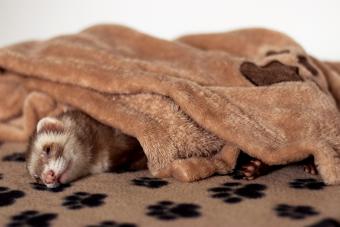
Keeping your ferret clean is part of a regular health care routine for your furry pet. While ferrets are generally very clean pets, baths may help reduce their musky odor. However, in some cases, bathing can actually make it stronger. Learn how and when to bathe your ferret, and you'll help them stay healthy and happy.
How Often Should You Bathe a Ferret?
There is some debate among ferret lovers about how often you should bathe a ferret. Opinions differ, with some sources recommending infrequent baths for ferrets, and other sources suggesting that owners not bathe ferrets at all.
Many experts note that bathing ferrets removes essential oils from their coats, leaving their skin dry. This can actually make your ferret's glands -- known as the sebaceous glands -- work overtime producing the natural oils that give your pet their characteristic "musky" scent, leaving your ferret smellier than before their bath.
Also, ferrets are inherently clean animals. Most sources agree that frequent bathing is likely to do more harm than good. They groom themselves in much the same way cats do, which means you should seldom -- if ever -- need to bathe them yourself.
However, if your pet gets especially dirty after an adventure, or if they somehow cover themselves in something they can't remove easily, such as sticky substances or something they shouldn't consume when they go to lick it off themselves, you may want to bathe them. You will have to judge based on what works best for your ferret.
Just remember that giving your pet too many baths too frequently can dry out their skin and fur and lead to additional problems, such as irritated skin and skin infections. One compromise is to spot-clean your pet, or wash your ferret with water only if they're dirty, and save the baths with shampoo for only a few times per year.
Keeping Your Ferret Stress-free During a Bath
Giving a ferret a bath can be stressful for the ferret, so if this is the first time for both of you, go slowly and pair the bath with things the ferret loves, such as some tasty ferret treats.
Start out by letting them explore the area where you will be giving them baths. Pick a bathtub, sink, or plastic tub, and give them ample time to sniff it out. Place them inside, without any water, and let them move around. Pair this with some treats.
Next, slowly add some water in while giving them treats and talking in a happy, calm tone of voice. Make sure that you keep the water level low so your ferret can stand in the water with their feet touching the ground. This helps them feel stable and reduces their fear.
Some ferrets do better if you put a plastic or rubber bath mat in the tub so their feet feel more secure. Continue talking to your ferret in a happy, relaxed tone of voice and let them get used to the water. End the "bath" after about five to 10 minutes without using any shampoo. You are just getting them used to water at this point.
Depending on how your ferret accepted being in the water, you may want to repeat this step a few times before moving on to actually bathing. Realize your ferret may never come to love bath day, but they can learn it's tolerable, and there are benefits to the experience. Keep it positive and don't press them if they're frightened during the process.
Cleaning the Cage Before Bathtime
If you're going to bathe your ferret, make sure you include cleaning their cage and replacing their bedding as part of the process. You want to clean any items that will be holding bad odors and dirt away before putting your clean ferret back inside. If they have a litter box, clean this as well before returning them to the cage. All of this should be done prior to giving the ferret a bath, so the cage is ready to go once they're cleaned.
Bathing Supplies

Once you're ready to give your ferret a bath and you've acclimated them to the bathing spot, it's time to clean them. Gather the supplies you will need to bathe your ferret before you do anything. You will need:
-
Some dry clean towels, with at least one place on the floor or counter before you start the bath.
-
Shampoo made for ferrets, such as 8 in 1 FerretSheen. You can also use baby shampoo with a tear-free formula.
-
Ferret conditioner can help with their skin oils, but it isn't necessary.
-
A bathing spot, such as a bathtub, sink, or plastic tub.
-
Warm (not hot) water.
-
Some ferret treats and ferret toys.
Getting into the Bathtub
Fill the bathing area with warm water that is neither too hot nor cold. Fill the tub up with enough water so they can get wet but can still stand. During the bath, you will need to support the ferret with one hand to keep them feeling secure while using your other hand to bathe them. You will also want to mix in giving them treats throughout this process.
Place the ferret in the tub and gently scoop water with your hands onto them to get their body, tail, and legs wet. Avoid getting water on their head, ears, and eyes. If your ferret enjoys toys, you can toss a ball in the water so they can bat at it while you work on cleaning them.
Washing with Shampoo

Place a few small drops of the shampoo in your hand. A little shampoo goes a long way, so you only need about a ¼ teaspoon of shampoo in your hand. Some ferret owners will warm up the shampoo first by placing it under hot running water or in a bowl of hot water. This can make the ferret more comfortable, but it isn't required.
With your other hand, pick the ferret up above the water and then rub the shampoo gently through your ferret's fur. Work it through their body, legs, and tail. Avoid getting shampoo anywhere near the ferret's head, particularly their ears, eyes, nose, and mouth.
To wash the ferret's head, you can either use your fingertips to clean gently while avoiding sensitive areas, or you can dip a cotton ball or cloth in the water and dab at their face area gently. Repeat this with a damp cloth to rinse out their fur.
Place the ferret back in the water and scoop water onto them and run it through their fur to rinse out the shampoo. You can use a cup or your hands to scoop the water. If your ferret likes water, you can even use the running faucet, as long as you protect their head area.
Empty out the water and add some fresh water in and continue rinsing your ferret. If you still see bubbles running out in the clean water, this is a sign you need to rinse the fur out more. If you have to do this a few times, this is a sign you used too much shampoo and should readjust the amount next time. If you decide to use conditioner, add it once the shampoo is rinsed out using the same steps.
Getting Out of the Tub

Place your ferret on the dry towel that you have on the floor or on a counter and wrap the sides around the ferret to make a "ferret burrito." Gently rub the towel all over their body to get the excess water out. If the towel becomes soaked, replace it with a dry towel.
Make sure your ferret is as dry as possible before putting them back in their cage, as a damp ferret can catch a chill and get sick. At the same time, many ferrets find this part of the process irritating, and you don't want to stress them out by rubbing them too much with the towel.
If your ferret dislikes being toweled off, place them in a small area, such as in a plastic tub or small cage, and fill it with towels. Most ferrets will tunnel and roll around the towels and dry themselves off and enjoy doing it on their own. If your ferret isn't afraid of a blow dryer, you can use it to dry them. Make sure you keep the dryer to the lowest heat and blower settings.
Grooming Requirements

In addition to bathing, your ferret will also need a regular grooming regimen.
-
Trim nails after the bath using either small animal clippers or kitten nail trimmers.
-
Clean ears monthly with an ear cleaning solution made for ferrets.
-
Brush teeth regularly with a cat toothbrush.
-
Brush weekly with a small animal brush or grooming mitt. Check their fur during brushing sessions to look for fleas or other parasites or signs of irritated, dry skin.
Bathing Your Ferret Doesn't Have to Be Stressful
Some ferrets adore playing in the water, while others find it very unpleasant. Always work with your ferret, and accommodate their personality and fears, by moving slowly and pairing baths with treats, toys, and gentle, happy talk. If you follow the steps, you and your ferret will get through the bathing process with flying colors!







